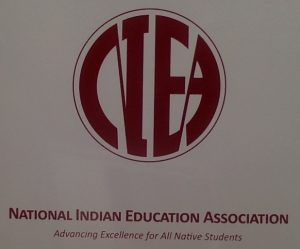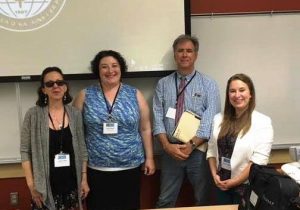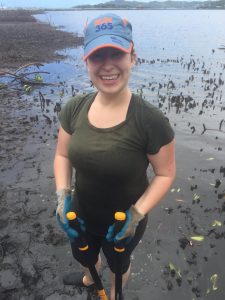In 1983, my father was a young Native graduate student organizer at the University of North Carolina at Chapel Hill. Thirty years later, I followed in his footsteps as a graduate student at the same institution. In the years between, little had changed for Native students. Many of the issues for which we advocated were consistent with earlier efforts in which my father and his peers had been engaged. Now, as a professor of Indigenous Studies, the issues around which my students are organizing have a familiar feel.
Institutions are incredibly adept at replicating themselves. The status quo remains the status quo, as demonstrated by generations of students asking for the same investments in their well-being. And yet, in the wake of what NPR has deemed the “summer of racial reckoning,” we find ourselves in a critical time to pause, reflect, and act.
Since the murder of George Floyd by Minneapolis police, many of us have responded by writing impassioned statements and forming reading groups. But as in previous moments of potential transformation, our actions are in danger of falling into one of two traps: eloquent calls that result in no action or symbolic action that does little to counter colonialism and systemic racism. Emerging from our first responses, what do we do now? How do we follow through on our initial commitments?
Generations of student activists – activists like my father, his former classmates, my former classmates, and my students – have been telling us what to do. Too often, we haven’t listened.
As we begin a new school year, some universities are listening and acting, including by amending their relationship with policing. But many others have stopped at words of support. Others are too distracted by the crisis of managing COVID cases on campus. We cannot let mismanagement of the pandemic distract us from our focus on antiracism, and we need to do more to ensure our rhetoric leads to systemic change.
To do so, we need to imagine our potential for change more expansively, taking the time to learn, dream, connect, and act. I propose four steps to begin:
Name our current reality and how we got here:
Over the summer, monuments to a settler colonial and racist past tumbled across the country. As the United States reckons with its histories of racist and settler colonial violence, those in higher education must explicitly discuss how we (and our disciplines) came to be where we are. We must unflinchingly examine how attempted genocide, slavery, and white supremacy have produced lucrative benefits for our institutions. We must research the histories of dispossession that resulted in our institutions’ land bases and financial well-being, and we must unearth the histories of enslavement that built the physical buildings in which many of us learn and teach. Only when we have named these histories, only when we have truly sat as a community with our own discomfort and anger, only then can we begin to take steps towards true institutional change. You cannot change what you refuse to knowledge.
Make space for disruptive daydreaming:
Acknowledging this history and our current realities, what if our campuses could become something else? What might colleges be like if they were more flexible, more responsive, and more driven by principles of dignity and compassion than profit or efficiency? What could our campuses be in their most caring forms? With these questions as opening provocations, what new realities might we imagine if we gave ourselves the gift of dreaming?
This is a time when we must imagine expansively, particularly as we recognize how truly far we still have to go. Drawing from education scholars Leilani Sabzalian (Alutiiq), Susan D. Dillon (Potawatomi/Lenape), and Roger I. Simon, this is a time to engage in a form of disruptive daydreaming that allows us to imagine “that which is not yet” and consider “what would have to be done for things to be otherwise.”
As a new professor on the tenure clock, I recognize that our research, teaching, and service often leave us inadequate time to dream. That’s why this requires institutional support. What if our institutions created spaces for faculty, staff, students, and community partners – particularly those whose identities are so often marginalized within our campuses – to dream together? For faculty, what if they offered course releases, service waivers, or stipends to engage in these re-imaginings, recognizing and compensating this labor of imagining and creating more just institutions?
Identify, strengthen, and engage our relationships:
As Bettina Love tells us in a recent op-ed and in her new book We Want to do More than Survive, these kinds of dreams “are not whimsical, unattainable daydreams” but rather “critical and imaginative dreams of collective resistance.” They demand action to convert them to reality.
To realize our dreams, we must commit to building collectively. If our relationships with campus and community partners are not what they ought (or need) to be, let that be a call to pause, visit, and be with one another. As we foreground an ethic of care and compassion for our campuses, our planning processes toward more just learning communities must be similarly grounded in good relations with one another. We can find common purpose around a shared mission to “breathe together” as we collectively “unmake this world.”
This requires careful planning. As networks committed to shaping just, enriching, and equitable learning communities, we can engage in asset mapping and power mapping our institutions as we connect with the many staff, faculty, centers, ideas, courses, community partners, and alumni whose work might partner with our own.
Strategize together to convert our dreams to reality:
With our dreams and maps in hand, we can employ the principles of backwards design that so many of us use in our course planning already. Starting with our vision and breaking down the necessary steps that might get us there, we can identify action steps to shape a new reality, one which emerges from our expansive imaginings and deep-seated hopes.
That’s the plan. My formation of these steps is not groundbreaking, but it does take time, commitment, and community. And while I imagine that for some readers this plan may feel naïve, unproductive, or even unfeasible, members of our communities – students, staff, faculty, and alumni – have been doing this for generations. On our campuses, they have named our histories, yearned for alternative realities, and worked alongside each other to achieve greater equity and justice for all of us. It is high time we joined them in this work.

 rom today came from states and tribes who are already engaged in the meaningful, ongoing consultation that can lead to positive results for kids. Notable examples included the work of the 39 Oklahoma tribes in conversation with state school superintendent Joy Hofmeister to offer 10 (!!!) Native languages as foreign languages to satisfy graduation requirements and to bring the Native high school graduation rate to 82%. As Superintendent Hofmeister noted, “It begins with consultation and collaboration with ESSA.” Also notable was the example of the Baboquivari school district in Arizona which has utilized the structures and resources at its disposal to reinvigorate a local public school district, drawing on Impact Aid funds to invest in teachers and using the state’s alternative certification program to bring in high quality language and culture instructors. There are thrilling examples of how charter schools can work for Native communities when they’re developed by the community based on community needs and values (not brought in from elsewhere), and I can’t wait to learn more about the work that Kara Bobroff is doing with the Native American Community Academy and NACA Inspired Schools Network. Perhaps the most exciting example of the day for me came from Sam Morseau with the Pokagon Band of Potawatomi. In preparing for ESSA, tribes in Michigan passed a strategic resolution which gives tribes the power to designate their liaison to the state for the purposes of working on ESSA. This resolution, passed by both individual tribes and by the United Tribes of Michigan, became part of the Michigan state plan for ESSA rollout which is now up for public comment.
rom today came from states and tribes who are already engaged in the meaningful, ongoing consultation that can lead to positive results for kids. Notable examples included the work of the 39 Oklahoma tribes in conversation with state school superintendent Joy Hofmeister to offer 10 (!!!) Native languages as foreign languages to satisfy graduation requirements and to bring the Native high school graduation rate to 82%. As Superintendent Hofmeister noted, “It begins with consultation and collaboration with ESSA.” Also notable was the example of the Baboquivari school district in Arizona which has utilized the structures and resources at its disposal to reinvigorate a local public school district, drawing on Impact Aid funds to invest in teachers and using the state’s alternative certification program to bring in high quality language and culture instructors. There are thrilling examples of how charter schools can work for Native communities when they’re developed by the community based on community needs and values (not brought in from elsewhere), and I can’t wait to learn more about the work that Kara Bobroff is doing with the Native American Community Academy and NACA Inspired Schools Network. Perhaps the most exciting example of the day for me came from Sam Morseau with the Pokagon Band of Potawatomi. In preparing for ESSA, tribes in Michigan passed a strategic resolution which gives tribes the power to designate their liaison to the state for the purposes of working on ESSA. This resolution, passed by both individual tribes and by the United Tribes of Michigan, became part of the Michigan state plan for ESSA rollout which is now up for public comment.
